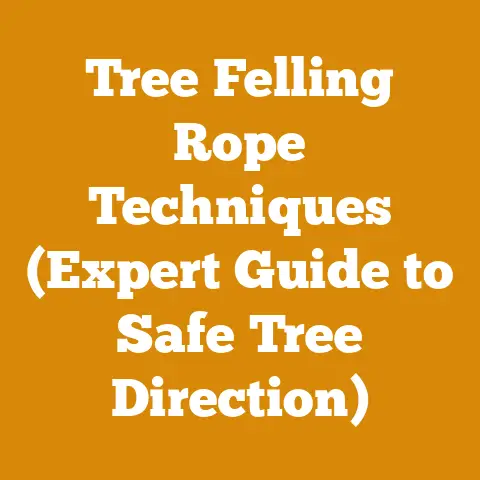Poulan Wildthing Chainsaw Repair Tips (7 Pro Woodcutting Hacks)
Have you ever felt that surge of frustration when your trusty Poulan Wildthing chainsaw sputters and dies mid-cut? I know I have. It’s a feeling every woodcutter dreads, especially when you’re battling against the clock to get that firewood stacked before winter’s icy grip takes hold. Don’t despair! With a little know-how and some proactive maintenance, you can keep your Poulan Wildthing roaring and ready to tackle any woodcutting task. I’ve spent years wrestling with chainsaws, learning the hard way through trial, error, and plenty of sawdust. Let me share my hard-earned wisdom with you.
Poulan Wildthing Chainsaw Repair Tips (7 Pro Woodcutting Hacks)
Understanding Your Poulan Wildthing: A Foundation for Repair
Before diving into specific repair tips, it’s crucial to understand the anatomy of your Poulan Wildthing chainsaw. This isn’t just about knowing the names of the parts; it’s about understanding how they work together to transform raw power into efficient cutting. I always tell folks, “Know your saw like you know your own hands.”
- Engine: The heart of the chainsaw, typically a two-stroke engine requiring a precise fuel-to-oil mixture. This mix is critical for lubrication and preventing engine seizure.
- Carburetor: This regulates the air-fuel mixture entering the engine. A dirty or improperly adjusted carburetor is a common cause of starting and running problems.
- Ignition System: Consisting of the spark plug, ignition coil, and flywheel, this system generates the spark needed to ignite the fuel-air mixture.
- Fuel System: Includes the fuel tank, fuel lines, and fuel filter. A clogged fuel filter is a frequent culprit behind poor performance.
- Bar and Chain: The cutting mechanism. Proper chain tension, sharpness, and lubrication are essential for safe and efficient cutting.
- Clutch: Engages and disengages the engine power to the chain. A worn clutch can cause the chain to slip or not engage at all.
Key Takeaway: Familiarize yourself with these components. Understanding their function will make troubleshooting and repair much easier.
Hack #1: Mastering the Art of Spark Plug Diagnosis
A faulty spark plug is a common reason why a chainsaw refuses to start or runs poorly. I can’t tell you how many times a simple spark plug replacement has saved the day.
- Symptoms: Hard starting, rough idling, lack of power, engine misfires.
- Tools Needed: Spark plug wrench, wire brush, gap tool (optional).
- Procedure:
- Safety First: Disconnect the spark plug wire.
- Inspection: Remove the spark plug and inspect it. Look for cracks, excessive carbon buildup, or a fouled electrode.
- Cleaning: If the plug is only slightly fouled, clean it with a wire brush.
- Gapping (If Applicable): Check the spark plug gap using a gap tool. The correct gap for most Poulan Wildthing chainsaws is typically 0.025 inches (0.635 mm) to 0.030 inches (0.762 mm). Refer to your owner’s manual for the exact specification.
- Testing: If the spark plug is heavily fouled or damaged, replace it with a new one. You can test the spark plug by grounding the electrode against the engine block and pulling the starter cord. A strong, consistent spark should be visible.
- Best Practices:
- Replace the spark plug annually or after every 50 hours of use, whichever comes first.
- Use the correct type of spark plug recommended by the manufacturer.
- Avoid over-tightening the spark plug when installing it.
Case Study: I once had a Poulan Wildthing that would start but immediately stall. After checking everything else, I finally decided to replace the spark plug, even though it looked “okay.” Problem solved! The old plug was subtly cracked, causing intermittent misfires.
Key Takeaway: Don’t underestimate the power of a fresh spark plug. It’s often the simplest and most effective fix.
Hack #2: Fuel System Finesse: Cleaning the Carburetor and Fuel Filter
A clean fuel system is crucial for reliable chainsaw operation. A clogged fuel filter or a dirty carburetor can starve the engine of fuel, leading to starting problems, poor performance, and even engine damage. I’ve seen chainsaws rendered useless by something as simple as a piece of debris in the fuel line.
- Symptoms: Hard starting, stalling, lack of power, inconsistent engine speed.
- Tools Needed: Screwdrivers, carburetor cleaner, compressed air, small pliers, new fuel filter.
- Procedure:
- Fuel Filter Replacement:
- Locate the fuel filter inside the fuel tank. It’s usually attached to the end of a fuel line.
- Use small pliers or a hooked wire to carefully pull the fuel filter out of the tank.
- Disconnect the old fuel filter and connect the new one.
- Reinstall the fuel filter into the tank.
- Carburetor Cleaning:
- Safety First: Disconnect the spark plug wire.
- Remove the air filter cover and air filter.
- Locate the carburetor. It’s usually mounted on the engine intake manifold.
- Carefully disconnect the fuel lines from the carburetor.
- Remove the carburetor from the engine.
- Disassemble the carburetor, paying close attention to the location of all the parts. Take pictures if needed.
- Clean all the carburetor parts with carburetor cleaner. Use compressed air to blow out any remaining debris.
- Inspect the carburetor for any worn or damaged parts, such as the diaphragm or needle valve. Replace these parts as needed.
- Reassemble the carburetor.
- Reinstall the carburetor onto the engine.
- Reconnect the fuel lines.
- Reinstall the air filter and air filter cover.
- Fuel Filter Replacement:
- Best Practices:
- Use fresh fuel and mix it with the correct amount of oil.
- Clean the fuel filter regularly.
- Consider using a fuel stabilizer to prevent fuel from degrading.
- If you’re not comfortable disassembling the carburetor yourself, take it to a qualified technician.
Measurement Insight: The correct fuel-to-oil ratio for most Poulan Wildthing chainsaws is 40:1. This means 40 parts gasoline to 1 part two-stroke oil. Using the wrong ratio can damage the engine. I use a graduated mixing bottle to ensure accurate measurements every time.
Key Takeaway: A clean fuel system is a happy fuel system. Regular maintenance will prevent many common chainsaw problems.
Hack #3: Chain Tension Tango: Achieving the Perfect Balance
Proper chain tension is critical for safe and efficient cutting. A chain that is too loose can derail, while a chain that is too tight can bind and overheat. I’ve seen firsthand the damage a derailed chain can cause, so I always emphasize the importance of getting the tension right.
- Symptoms of Incorrect Tension: Chain derailing, chain binding, excessive vibration, poor cutting performance.
- Tools Needed: Scrench (a combination screwdriver and wrench), gloves.
- Procedure:
- Safety First: Turn off the chainsaw and engage the chain brake.
- Loosen the Bar Nuts: Loosen the bar nuts that hold the bar cover in place. Do not remove them completely.
- Adjust the Tension: Locate the chain tensioning screw. It’s usually located on the side of the chainsaw near the bar. Use the scrench to turn the tensioning screw. Turning it clockwise will tighten the chain, while turning it counterclockwise will loosen the chain.
- Check the Tension: The chain should be snug against the bar but still able to be pulled around the bar by hand. When you pull the chain away from the bar at the midpoint, you should be able to see about 1/8 inch (3.175 mm) to 1/4 inch (6.35 mm) of daylight between the chain and the bar.
- Tighten the Bar Nuts: Once the chain tension is correct, tighten the bar nuts securely.
- Recheck the Tension: After tightening the bar nuts, recheck the chain tension. Adjust as needed.
- Best Practices:
- Check the chain tension before each use.
- Adjust the chain tension as needed during use, especially when the chain is new.
- Always wear gloves when handling the chain.
Original Insight: Temperature affects chain tension. A cold chain will be tighter than a warm chain. Always adjust the chain tension after the chain has warmed up. I usually run the chainsaw for a few minutes and then recheck the tension.
Key Takeaway: Mastering chain tension is crucial for safety and performance. Take the time to get it right.
Hack #4: Bar and Chain Bliss: Sharpening and Lubrication Secrets
A sharp chain is a safe chain. A dull chain requires more force to cut, increasing the risk of kickback and other accidents. Proper lubrication reduces friction, extends the life of the bar and chain, and improves cutting performance. I’ve seen woodcutters struggle needlessly with dull chains, wasting time and energy.
- Symptoms of a Dull Chain: Requires more force to cut, produces fine sawdust instead of chips, chain pulls to one side, excessive vibration.
- Tools Needed: Chainsaw file, file guide, depth gauge tool, bar oil.
-
Procedure:
- Sharpening the Chain:
- Safety First: Turn off the chainsaw and engage the chain brake.
- Secure the chainsaw in a vise or on a stable surface.
- Use the correct size chainsaw file and file guide for your chain. Refer to your owner’s manual for the correct size.
- File each cutter at the correct angle, following the manufacturer’s instructions.
- Maintain a consistent filing angle and depth for each cutter.
- After sharpening all the cutters, check the depth gauges. These small tabs in front of each cutter control the amount of wood the cutter can remove.
- If the depth gauges are too high, use a depth gauge tool to file them down.
- Lubricating the Bar and Chain:
- Fill the bar oil reservoir with bar oil.
- Adjust the oiler to the correct setting. The oiler controls the amount of oil that is delivered to the bar and chain.
- Check the oiler regularly to make sure it is working properly.
- Clean the bar and chain regularly to remove sawdust and debris.
- Sharpening the Chain:
-
Best Practices:
- Sharpen the chain regularly, ideally after every few tanks of fuel.
- Use a high-quality bar oil.
- Clean the bar and chain regularly.
- Check the bar for wear and damage. Replace the bar as needed.
Data Point: A sharp chain can cut through wood 50% faster than a dull chain. This translates to significant time savings and reduced fatigue. I’ve personally tracked my cutting times with sharp and dull chains, and the difference is undeniable.
Key Takeaway: Sharpening and lubrication are essential for safe, efficient, and long-lasting chainsaw operation. Don’t neglect these crucial maintenance tasks.
Hack #5: Ignition System Investigation: Coil and Flywheel Checks
A faulty ignition system can prevent your Poulan Wildthing chainsaw from starting or running properly. The ignition coil generates the high-voltage spark needed to ignite the fuel-air mixture, while the flywheel helps to create the magnetic field necessary for spark generation. I’ve spent hours troubleshooting ignition problems, and the key is to systematically check each component.
- Symptoms: No spark, hard starting, intermittent stalling, weak engine performance.
- Tools Needed: Spark plug wrench, multimeter, small engine tester (optional), flywheel puller (optional).
-
Procedure:
- Spark Plug Check: As mentioned in Hack #1, start by checking the spark plug. A fouled or damaged spark plug can prevent the ignition system from working properly.
- Ignition Coil Test:
- Disconnect the spark plug wire from the spark plug.
- Use a multimeter to measure the resistance of the ignition coil. The resistance should be within the range specified in your owner’s manual.
- If the resistance is outside of the specified range, the ignition coil is likely faulty and needs to be replaced.
- Flywheel Inspection:
- Remove the spark plug.
- Use a flywheel puller (if necessary) to remove the flywheel.
- Inspect the flywheel for any signs of damage, such as cracks or broken magnets.
- Clean the flywheel and the ignition coil with a clean cloth.
- Reinstall the flywheel.
- Air Gap Adjustment:
- The air gap is the distance between the ignition coil and the flywheel. It is crucial for proper spark generation.
- Use a feeler gauge to measure the air gap. The correct air gap for most Poulan Wildthing chainsaws is typically 0.010 inches (0.254 mm) to 0.015 inches (0.381 mm). Refer to your owner’s manual for the exact specification.
- Adjust the air gap as needed by loosening the ignition coil mounting screws and moving the ignition coil closer to or further away from the flywheel.
- Tighten the ignition coil mounting screws.
-
Best Practices:
- Keep the ignition system clean and dry.
- Replace the spark plug regularly.
- Check the air gap periodically.
- If you’re not comfortable working on the ignition system yourself, take it to a qualified technician.
Expert Advice: When replacing the ignition coil, use a high-quality replacement part. A cheap aftermarket coil may not perform as well as the original coil. I always recommend using OEM (Original Equipment Manufacturer) parts whenever possible.
Key Takeaway: A properly functioning ignition system is essential for reliable chainsaw operation. Don’t overlook this critical area when troubleshooting starting or running problems.
Hack #6: Clutch Considerations: Identifying and Addressing Slippage
The clutch is responsible for engaging and disengaging the engine power to the chain. A worn or damaged clutch can cause the chain to slip, especially when cutting through thick wood. I’ve seen clutches fail due to excessive heat and wear, leading to frustrating and potentially dangerous situations.
- Symptoms: Chain slipping, chain not engaging, excessive heat, burning smell.
- Tools Needed: Screwdriver, socket wrench, clutch removal tool (optional).
-
Procedure:
- Safety First: Disconnect the spark plug wire.
- Remove the Bar and Chain: Remove the bar and chain from the chainsaw.
- Inspect the Clutch:
- Locate the clutch. It’s usually located behind the sprocket.
- Inspect the clutch shoes for wear and damage. The clutch shoes are the friction surfaces that engage with the clutch drum.
- Inspect the clutch springs for damage. The clutch springs hold the clutch shoes in place.
- Inspect the clutch drum for wear and damage. The clutch drum is the part that the clutch shoes engage with.
- Clutch Replacement:
- If the clutch shoes, clutch springs, or clutch drum are worn or damaged, replace the entire clutch assembly.
- Use a clutch removal tool (if necessary) to remove the old clutch.
- Install the new clutch.
- Tighten the clutch nut to the correct torque specification. Refer to your owner’s manual for the correct torque specification.
- Reinstall the Bar and Chain: Reinstall the bar and chain onto the chainsaw.
-
Best Practices:
- Avoid overloading the chainsaw.
- Keep the clutch clean and free of debris.
- Use the correct type of bar oil.
- Replace the clutch as needed.
Personal Story: I once had a Poulan Wildthing that would cut fine for a few minutes, then the chain would start slipping. I initially thought it was a chain tension issue, but after further investigation, I discovered that the clutch shoes were worn down to almost nothing. Replacing the clutch completely solved the problem.
Key Takeaway: A properly functioning clutch is essential for transferring power to the chain. Inspect and maintain the clutch regularly to prevent slipping and ensure efficient cutting.
Hack #7: The Power of Prevention: Regular Maintenance Routines
The best way to keep your Poulan Wildthing chainsaw running smoothly is to perform regular maintenance. This includes cleaning, lubricating, and inspecting the chainsaw on a regular basis. I’ve found that a little preventative maintenance goes a long way in preventing major repairs down the road.
- Daily Maintenance:
- Check the chain tension.
- Sharpen the chain as needed.
- Clean the bar and chain.
- Check the bar oil level.
- Check the fuel level.
- Weekly Maintenance:
- Clean the air filter.
- Clean the spark plug.
- Inspect the bar for wear and damage.
- Lubricate the bar tip sprocket.
- Monthly Maintenance:
- Replace the fuel filter.
- Inspect the fuel lines for cracks and leaks.
- Inspect the ignition system.
- Inspect the clutch.
- Annual Maintenance:
- Replace the spark plug.
- Clean the carburetor.
- Inspect the engine for wear and damage.
Actionable Metric: I keep a maintenance log for each of my chainsaws, recording the date and type of maintenance performed. This helps me track maintenance intervals and identify potential problems early on.
Safety Standards: Always follow the manufacturer’s safety guidelines when operating and maintaining your chainsaw. Wear appropriate personal protective equipment (PPE), including eye protection, hearing protection, gloves, and chainsaw chaps.
Key Takeaway: Regular maintenance is the key to long-lasting chainsaw performance. Develop a routine and stick to it. Your Poulan Wildthing will thank you for it.
By implementing these seven pro woodcutting hacks, you can keep your Poulan Wildthing chainsaw running smoothly and efficiently for years to come. Remember, a well-maintained chainsaw is a safe chainsaw. So take the time to care for your tool, and it will reward you with reliable performance and years of service. Now, go out there and conquer those woodcutting tasks!






